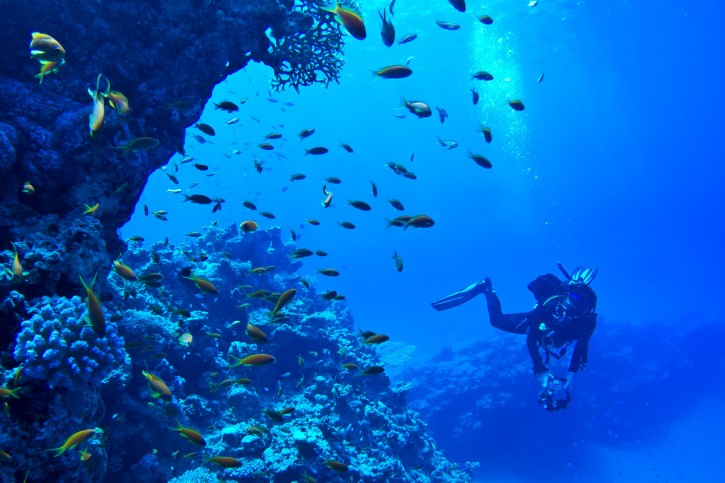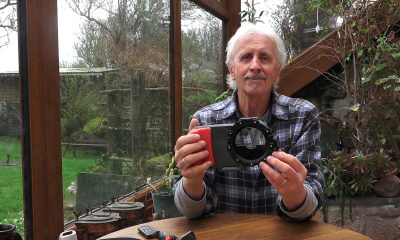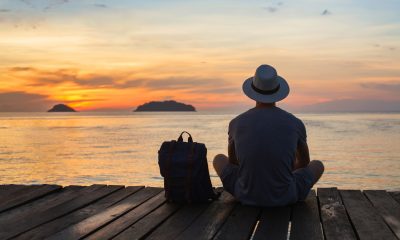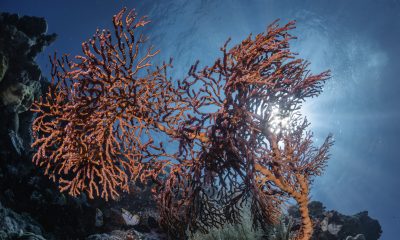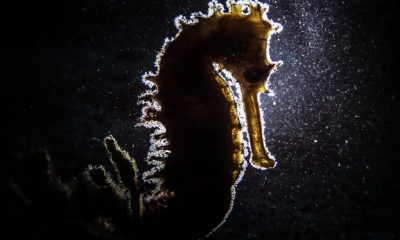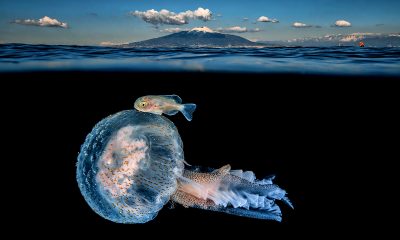News
Duxy’s Underwater Photography Blog: Available Light, Part 4
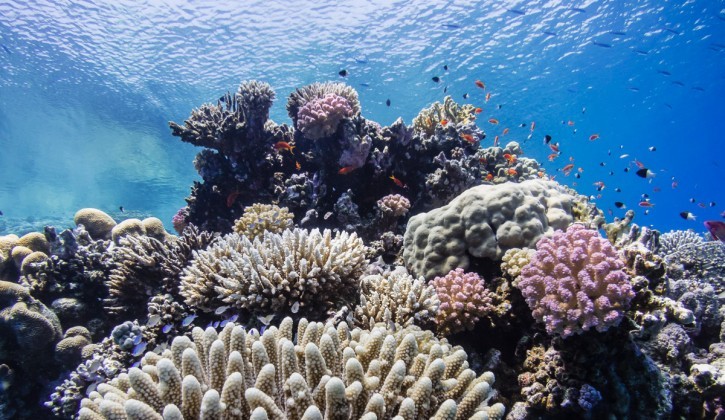
This is the final part in our series on shooting in available light. Part one was all about shooting with wide angle lenses; part two covered Custom White Balance; and part 3 was about the pitfalls and problems of shooting with Custom White Balance.
For the fourth and final instalment I am going to cover all of the extra bits and little things that don’t fall into the earlier sections.
So we are going to look at colour correction using filters and also colour correcting after the fact when you are shooting on a camera that produces RAW files.
Processing wreck shots, and whether or not to go black and white.
And is it possible to shoot available light macro?
Correction Filters and the Underwater Mode
Some cameras don’t have quick and easy to use Custom White Balance controls, which can put folks off. And they often want a one stop solution.
In days of yore, (and tbh sometimes these days too) with some cameras you had no option but to use a filter, which is normally of a reddish magenta colour, to restore colour balance to your underwater shots. And they work fine as long as you understand that they only really work within a very narrow band of depth, typically around 8-12m. This is because as explained in our earlier white balancing blog, our colours are diminished progressively as we get deeper, so any fixed method of colour correction such as a filter is really only going to work efficiently at one depth. And we would need a collection of filters of variable intensity as we got deeper, which is impractical to say the least.
To be honest, unless there is absolutely no alternative with your camera (GoPro’s and other cameras of this type fall into this category), I would steer away from conventional colour correction filters because they also steal quite a bit of light from you. Or as in the cases below only shoot with them really shallow – no deeper than around 8m – for the best results.
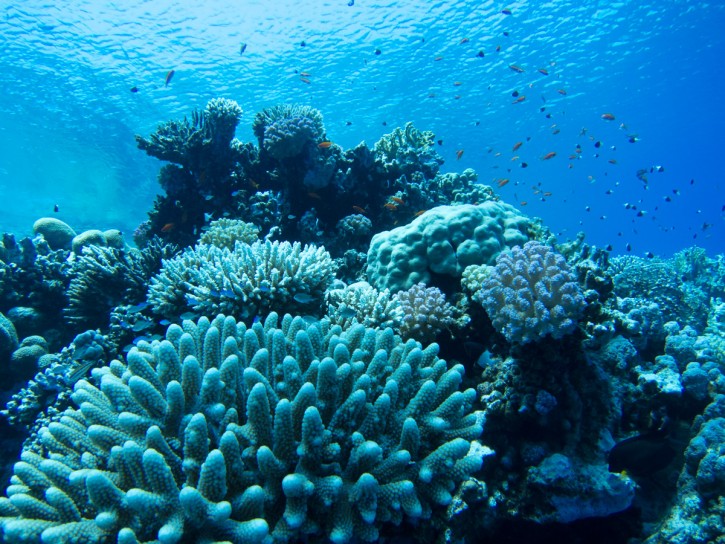
A classic reef scene that could be taken with any camera from a GoPro upwards. This is unfiltered and what a lot of people experience when first shooting underwater.
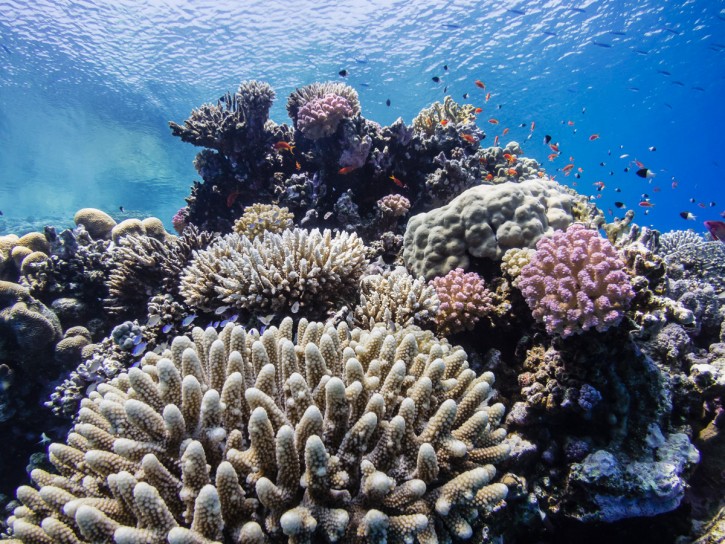
Here the same shot as previous, but this time I’ve used a colour correction filter to restore the colours. Note however that I am very shallow and this is where these filters work best.
Some cameras have a dedicated underwater mode, but this is usually little more than an electronic version of a coloured filter and doesn’t always do much, but of late I’ve seen some more promising offerings of this sort of thing from Canon and Olympus.
Here’s a video I shot using the underwater mode on an Olympus Mirrorless camera, an EM5:
https://www.youtube.com/watch?v=Ulat1Z6L0qk
Shooting in the RAW
Probably the very best way to colour correct your pictures, even if you have the option of custom white balance, is if your camera will allow you to shoot RAW files.
Now if you are not sure, the chances are that your camera won’t, as the ability to shoot RAW will be something you will probably have looked at when buying a camera, and also the salesman will have made a big deal out of it, because it is a big deal. So you know what to ask for when you purchase your next camera.
RAW files are simply the actual data recorded at the sensor and are not processed into a jpeg file within the camera.
The means that you can have full control after you’ve taken your shots to process the pictures yourself, and really fine tune things like colour correction, white balance and even exposure to a lesser degree. This processing you would do within a program like Adobe Photoshop or Adobe Lightroom, and this is why things like RAW shooting are available to people with high end compact cameras or Mirrorless and DSLR shooters.
It’s nothing to be intimidated about and processing RAW files is a relatively easy task, and is also quite fun too. A bit like the modern equivalent of having a home darkroom, but without the dangerous chemicals and fumbling around in the dark!
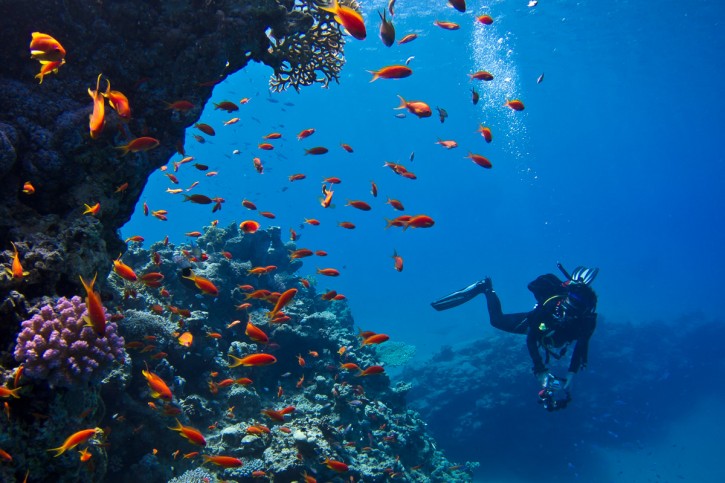
After colour correction within Adobe Lightroom, the RAW file has allowed me to completely restore the colours, but beware – this won’t work miracles, and at depths greater than 12m, it has less usefulness, and maybe using a strobe would be better.
Macro Photography in Available Light
Underwater macro or close up photography is often thought to be only practical if you use extra lighting of some kind. If you encounter subjects that are in good light like the Hawkfish below, then there is no reason as long as your shutter speeds and apertures of your camera will allow to shoot with what the sun is providing for you. This can often be simpler and produce more naturalistic results.
So keep an eye on what your camera is telling you, and if the camera shake warning is flashing then you may need to up your ISO’s to provide a suitable shutter speed to hand hold. On that note hand holding close up shots is more tricky than wide angle so you may need to pick (or force shutter speeds with a higher ISO) than you could get away with with a wider lens. I try and keep above 1/250 of a second if shooting like this.
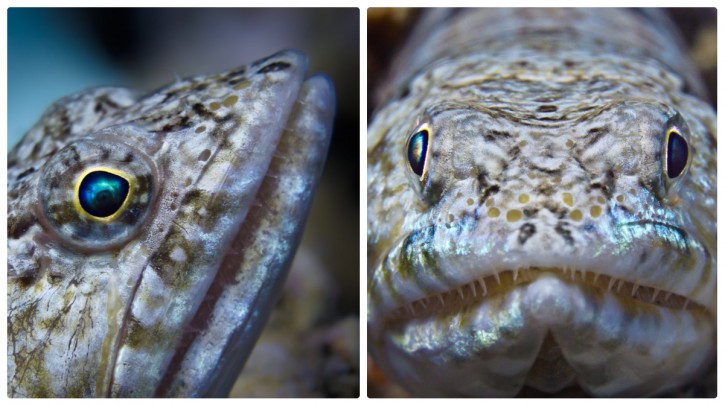
This Lizard fish is about as close as you could expect to shoot successfully without a strobe. These guys are often in very shallow water, laying on bright well lit sand, so are a very suitable subject for available light macro photography.
Fish portraiture like this is perfectly achievable using available light, and allows you to capture the subject exactly as you see it. The things you need to watch out for are that your shutter speeds are sufficiently high enough to hand hold your camera set up, because in macro mode you may also be zoomed in slightly so any movements you make will be magnified. These two shots below were typical examples of pictures where I wanted to get the shot exactly as I was seeing it, and whilst the Crocodile Fish is only just qualified to be called a macro picture, everything I’ve said above applies.
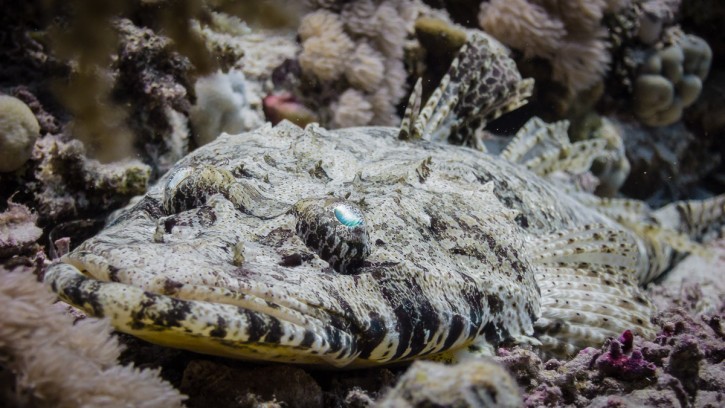
Fish Portraits like the ones here shot using compact cameras and underwater white balance, or RAW files, is very possible in very bright light conditions.
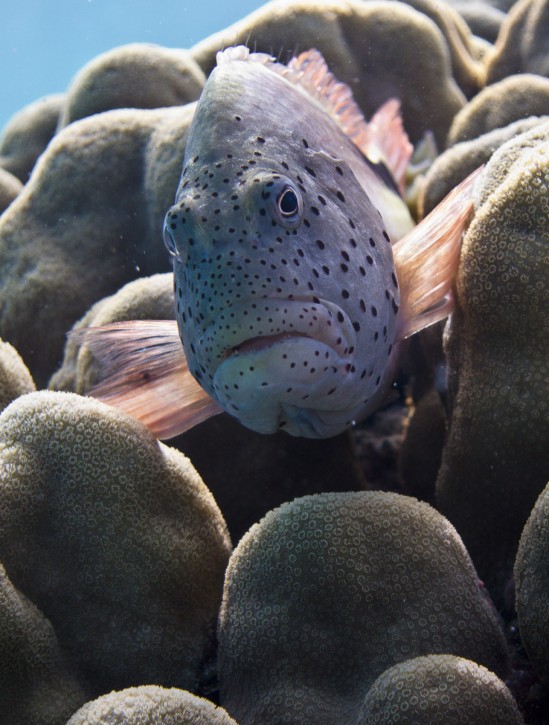
Macro Photography is normally the preserve of someone shooting with strobes only, but as long as you are in good light Macro photography is possible.
Available light wreck shooting
A very popular subject for available light shooting is to shoot big expansive wreck photographs, and often shooting available light is the only way possible to light such a large object, because even with the most powerful strobes it would be nigh on impossible to completely illuminate a large subject like a wreck. Unless the light conditions are in your favour, and the wreck is positioned so that the sun is directly illuminating it, when you want to shoot it, then getting your colours correct will depend hugely on all these variables. Just one of the reasons why people often choose to turn their wreck photographs to black and white – this not only heightens the drama and mood but is often the only get out clause to avoid weird colours, because the conditions are not in your favour.
For the stern shot of the Thistlegorm, I have actually used a little bit of flash, but it has only slightly lightened the very closest part of the wreck, and lifted it a little. To all intents and purposes the shot is being mostly illuminated by the late afternoon sunlight.
So I will leave it up to you which you prefer, the straight shot or the black and white toned version below it:
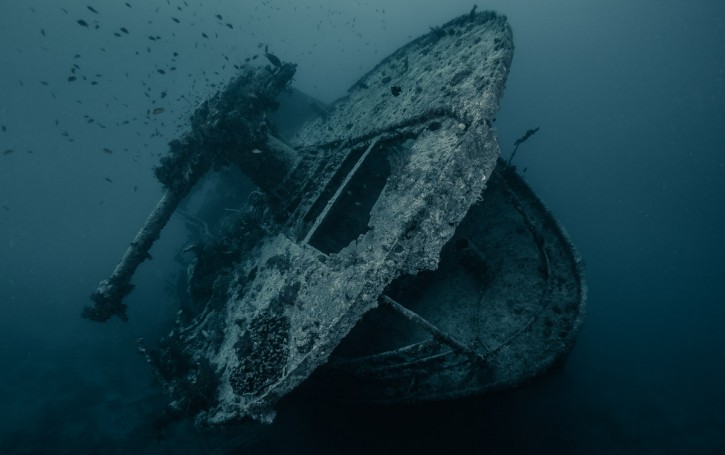
A shot at the stern, where I have been lucky enough to have no other divers in the scene, which if you’ve been to the Thistlegorm, you’ll realise is rare indeed. This is with only a tiny amount of flash lighting up the very closest part of the wreck.
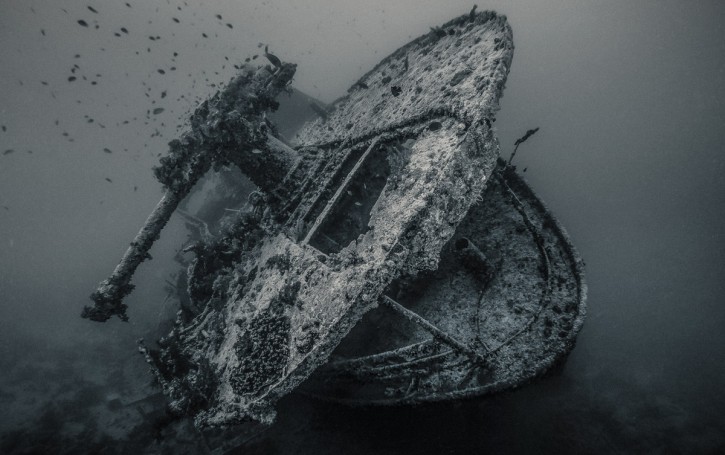
The black and white version of the stern shot of the Thistlegorm. It’s a matter of personal taste which one you prefer. Making black and white edits like this is a question I get asked a lot on our photo workshops.
The side on shot which is an unusual angle. I have given you the straight shot at the top with little or no editing, and then the more stylised black and white version below it:
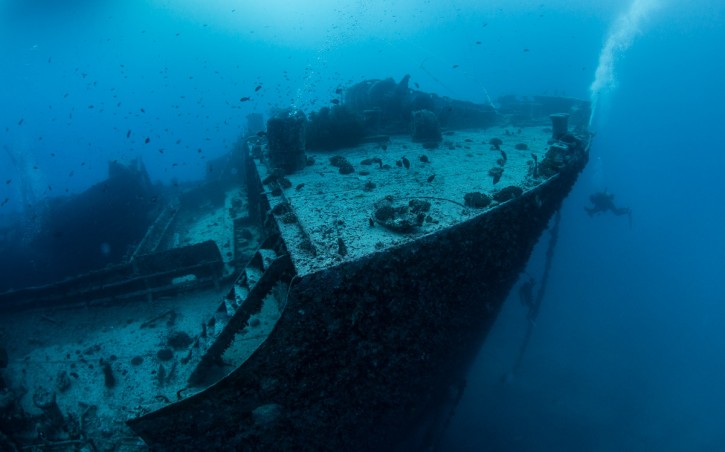
This is a rather untraditional viewpoint of the Thistlegorm, taken sideways on at the bow. The picture is a little soft at the edges because of the wide aperture I have had to use to gain a sufficiently fast shutter speed to hold the camera steady.
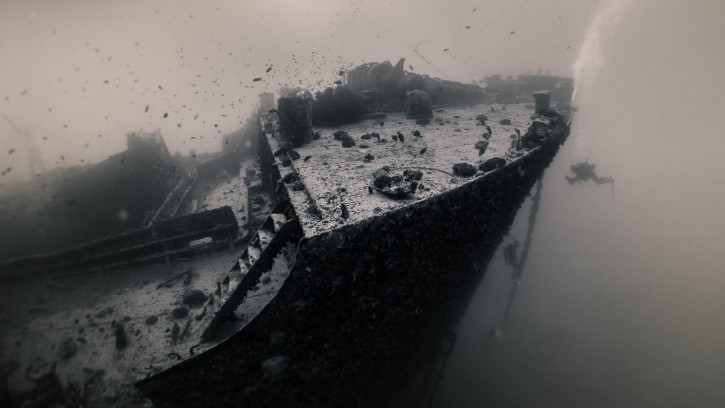
Because of the wide aperture I used which has softened the edges somewhat, I decided to opt for a black and white edit which actually highlights the softer edges to try and give it a dated and otherworldly feel.
Another alternative is to come on a dedicated wreck photography week where we will often dive the same wreck many times throughout the day to raise the chances of good lighting. I spend a lot of time on these trips teaching people how to edit their pictures, with black and white editing particularly popular.
I hope you’ve enjoyed this series on available light shooting. If you’d like to ask me any questions or talk about our photo trips please drop me a line at duxy@scubatravel.com.
[hr style=”single”]
 Duxy is the in house photo-pro for UK-based dive tour operator Scuba Travel. To find out about availability on Scuba Travel’s underwater photography workshops hosted by Duxy click here.
Duxy is the in house photo-pro for UK-based dive tour operator Scuba Travel. To find out about availability on Scuba Travel’s underwater photography workshops hosted by Duxy click here.
Blogs
Northern Red Sea Reefs and Wrecks Trip Report, Part 3: The Mighty Thistlegorm

Jake Davies boards Ghazala Explorer for an unforgettable Red Sea diving experience…
Overnight, the wind picked up, making the planned morning dive a bit bumpy on the Zodiacs to the drop point on Thomas Reef. There, we would dive along the reef before descending through the canyon and then passing under the arch before ascending the wall with a gentle drift. The site provided great encounters with more pelagic species, including shoals of large barracuda, tuna, and bigeye trevally.
Once back on the boat, it was time to get everything tied down again as we would head back south. This time, with the wind behind us, heading to Ras Mohammed to dive Jackfish Alley for another great gentle drift wall dive before then heading up the coast towards the Gulf of Suez to moor up at the wreck of the Thistlegorm. This being the highlight wreck dive of the trip and for many onboard, including myself, it was the first time diving this iconic wreck. I had heard so much about the wreck from friends, and globally, this is a must on any diver’s list. Fortunately for us, there was only one other boat at the site, which was a rarity. A great briefing was delivered by Ahmed, who provided a detailed background about the wreck’s history along with all the required safety information as the currents and visibility at the site can be variable.

Kitting up, there was a lot of excitement on deck before entering the water and heading down the shoreline. Descending to the wreck, there was a light northerly current which reduced the visibility, making it feel more like the conditions that can be found off the Welsh coast. At 10m from the bottom, the outline of the wreck appeared as we reached the area of the wreck which had been bombed, as our mooring line was attached to part of the propeller shaft. Arriving on deck, instantly everywhere you looked there were many of the supplies which the ship was carrying, including Bren Carrier tanks and projectiles that instantly stood out.

We headed around the exterior, taking a look at the large propeller and guns mounted on deck before entering the wreck on the port side to take a look in the holds. It was incredible to see all the trucks, Norton 16H, and BSA motorcycles still perfectly stacked within, providing a real snapshot in time.

Overall, we had four dives on the Thistlegorm, where for all of the dives we were the only group in the water, and at times, there were just three of us on the whole wreck, which made it even more special, especially knowing that most days the wreck has hundreds of divers. Along with the history of the wreck, there was plenty of marine life on the wreck and around, from big green turtles to batfish, along with shoals of mackerel being hunted by trevally. Some unforgettable dives.

The final leg of the trip saw us cross back over the Suez Canal to the Gobal Islands where we planned to stay the night and do three dives at the Dolphin House for the potential of sharing the dive with dolphins. The site, which included a channel that was teeming with reef fish, especially large numbers of goatfish that swam in large shoals along the edge of the reef. These were nice relaxing dives to end the week. Unfortunately, the dolphins didn’t show up, which was okay as like all marine life they are difficult to predict and you can’t guarantee what’s going to be seen. With the last dive complete, we headed back to port for the final night where it was time to clean all the kit and pack before the departure flight the next day.

The whole week from start to finish on Ghazala Explorer was amazing; the boat had all the facilities you need for a comfortable week aboard. The crew were always there to help throughout the day and the chefs providing top quality food which was required after every dive. The itinerary providing some of the best diving with a nice mixture of wreck and reef dives. I would recommend the trip to anyone, whether it’s your first Red Sea liveaboard in the Red Sea or you’re revisiting. Hopefully, it’s not too long before I head back to explore more of the Red Sea onboard Ghazala Explorer.

To find out more about the Northern Red Sea reef and wrecks itineraries aboard Ghazala Explorer, or to book, contact Scuba Travel now:
Email: dive@scubatravel.com
Tel: +44 (0)1483 411590
Photos: Jake Davies / Avalon.Red
Blogs
Northern Red Sea Reefs and Wrecks Trip Report, Part 2: Wall to Wall Wrecks

Jake Davies boards Ghazala Explorer for an unforgettable Red Sea diving experience…
The second day’s diving was a day full of wreck diving at Abu Nuhas, which included the Chrisoula K, Carnatic, and Ghiannis D. The first dive of the day was onto the Chrisoula K, also known as the wreck of tiles. The 98m vessel remains largely intact where she was loaded with tiles which can be seen throughout the hold. The stern sits at 26m and the bow just below the surface. One of the highlights of the wreck is heading inside and seeing the workroom where the machinery used for cutting the tiles are perfectly intact. The bow provided some relaxing scenery as the bright sunlight highlighted the colours of the soft coral reef and the many reef fish.

Following breakfast, we then headed to the next wreck, which was the Carnatic. The Carnatic is an 89.9m sail steamer vessel that was built in Britain back in 1862. She ran aground on the reef back in 1869 and remains at 27m. At the time, she was carrying a range of items, including 40,000 sterling in gold. An impressive wreck where much of the superstructure remains, and the two large masts lay on the seafloor. The wooden ribs of the hull provide structures for lots of soft corals, and into the stern section, the light beams through, bouncing off the large shoals of glass fish that can be found using the structure as shelter from the larger predators that are found outside of the wreck.

The final wreck at Abu Nuhas was the Ghiannis D, originally called ‘Shoyo Maru,’ which was 99.5m long and built in Japan back in 1969 before becoming a Greek-registered cargo ship in 1980. The ship then ran aground on the reef on April 19th, 1983, and now sits at the bottom at a depth of 27m. Heading down the line, the stern of the ship remains in good condition compared to the rest of the hull. The highlight of the wreck, though, is heading into the stern section and down the flights of stairs to enter the engine room, which remains in good condition and is definitely worth exploring. After exploring the interior section of the ship, we then headed over to see the rest of the superstructure, where it’s particularly interesting to see the large table corals that have grown at the bow relatively quickly considering the date the ship sank. After surfacing and enjoying some afternoon snacks, we made sure everything was strapped down and secured as we would be heading north and crossing the Gulf of Suez, where the winds were still creating plenty of chop.

The next morning, it was a short hop to Ras Mohammed Nature Reserve for the next couple of days of diving. The 6am wake-up call came along with the briefing for the first site we would be diving, which was Shark & Yolanda. The low current conditions allowed us to start the dive at Anemone City, where we would drift along the steep, coral-filled wall. These dives involved drifts, as mooring in Ras Mohammed wasn’t allowed to protect the reefs. As a dive site, Shark & Yolanda is well-known and historically had a lot of sharks, but unfortunately not so many in recent years, especially not so early in the season. However, there was always a chance when looking out into the blue.

The gentle drift took us along the steep walls of the site, with plenty of anemone fish to be seen and a huge variety of corals. It wasn’t long into the dive before we were accompanied by a hawksbill turtle, who drifted with us between the two atolls before parting ways. Between the two reefs, the shallow patch with parts of coral heads surrounded by sand provided the chance to see a few blue-spotted stingrays that were mainly resting underneath the corals and are always a pleasure to see. With this being the morning dive, the early sunlight lit up the walls, providing tranquil moments. Looking out into the blue, there was very little to be seen, but a small shoal of batfish shimmering underneath the sunlight was a moment to capture as we watched them swim by as they watched us.

Towards the end of the dive, we stopped at the wreck of the Jolanda where the seafloor was scattered with toilets from the containers it was carrying. This provided a unique site to make a safety stop, which was also accompanied by a large barracuda slowly swimming by, along with a hawksbill turtle calmly swimming over the reef as the sun rays danced in the distance.
For the next dive, we headed north to the Strait of Tiran to explore the reefs situated between Tiran Island and Sharm El Sheik, which were named after the British divers who had found them. We started on Jackson before heading to Gordons Reef, where we also did the night dive. All the atolls at these sites provided stunning, bustling coral reefs close to the surface and steep walls to swim along, which always provided the opportunity to keep an eye out for some of the larger species that can be seen in the blue. Midwater around Jackson Reef was filled with red-toothed triggerfish and shoals of banner fish, which at times were so dense that you couldn’t see into the blue. Moments went by peacefully as we enjoyed the slow drift above the reef, watching these shoals swim around under the mid-afternoon sun.

The night dive at Gordon’s Reef was mainly among the stacks of corals surrounded by sand, which was great to explore under the darkness. After some time circling the corals, we came across what we were really hoping to find, and that was an octopus hunting on the reef. We spent the majority of the dive just watching it crawl among the reef, blending into its changing surroundings through changes in colour and skin texture. It’s always so fascinating and captivating to watch these incredibly intelligent animals, in awe of their ability to carry out these physical changes to perfectly blend into the reef. Before we knew it, it was time to head back to the boat to enjoy a well-deserved tasty dinner prepared by the talented chefs onboard.
Check in for the 3rd and final part of this series from Jake tomorrow!
To find out more about the Northern Red Sea reef and wrecks itineraries aboard Ghazala Explorer, or to book, contact Scuba Travel now:
Email: dive@scubatravel.com
Tel: +44 (0)1483 411590
Photos: Jake Davies / Avalon.Red
-

 News3 months ago
News3 months agoHone your underwater photography skills with Alphamarine Photography at Red Sea Diving Safari in March
-

 News3 months ago
News3 months agoCapturing Critters in Lembeh Underwater Photography Workshop 2024: Event Roundup
-

 Marine Life & Conservation Blogs2 months ago
Marine Life & Conservation Blogs2 months agoCreature Feature: Swell Sharks
-

 Blogs2 months ago
Blogs2 months agoMurex Resorts: Passport to Paradise!
-

 Blogs2 months ago
Blogs2 months agoDiver Discovering Whale Skeletons Beneath Ice Judged World’s Best Underwater Photograph
-

 Gear Reviews3 months ago
Gear Reviews3 months agoGear Review: Oceanic+ Dive Housing for iPhone
-

 Marine Life & Conservation2 months ago
Marine Life & Conservation2 months agoSave the Manatee Club launches brand new webcams at Silver Springs State Park, Florida
-

 News3 months ago
News3 months agoWorld’s Best Underwater Photographers Unveil Breathtaking Images at World Shootout 2023


